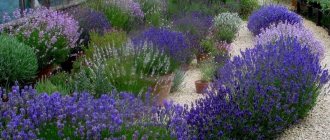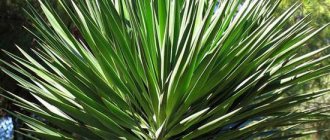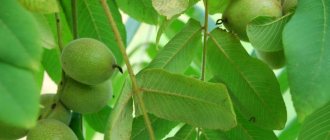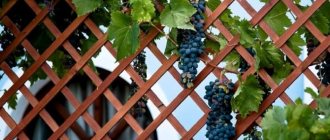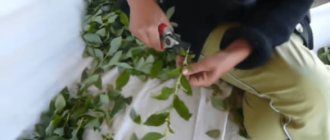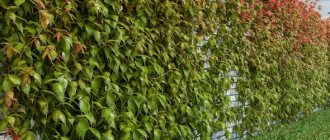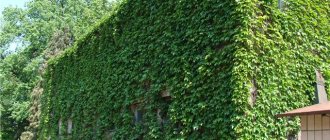The vine, which is like a woman's waist, not only delights a person, but also makes us humans think about how close we are to nature, that we are also children of nature. Many housewives arrange a “living corner” that is filled with an abundance of flowers: Decembrists, dracaenas, orchids, lemongrass, ficus and many others.
Scientists have proven that if a person looks at greenery (flowers, trees, landscapes) more often, his eyesight will never deteriorate. Flowers also clear the air, which helps our lungs cope. There are a huge number of advantages from having flowers nearby.
Capabilities of the vine
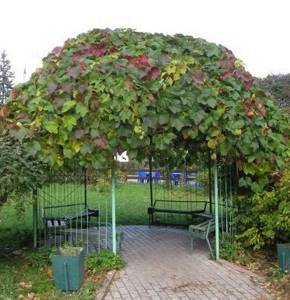
With what curiosity we observe on the Internet on various sites where beauty abroad is presented to our attention, where we see arbors for grapes or decorated with various flowers.
The thought immediately arises that this is probably somewhere in France or Italy. But we can also create such exquisite and beautiful gazebos, decorated with grapes, flowers, and rare plants! You just have to think and imagine... and your gazebo will become like the kingdom of a nymph or queen of the Amazons, who live in forests, jungles, appreciate the naturalness and virginity of nature, the air of freedom and the taste of life.
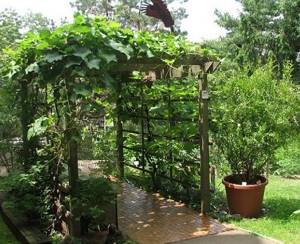
A gazebo built with your own hands is not only a presence or a small property, it is your abode, an outlet or a place associated with gatherings with friends, loved ones, and relatives. Each place always leaves a trace and memory in the soul. Sometimes, passing by some small section of the Embankment, we involuntarily remember what or who this place is associated with and connected with.
Your gazebo will become a wonderful past, a happy present and a bright future, where you will gather with friends for evening tea parties, barbecues, conversations, conversations with a guitar, or you will begin to philosophize and indulge in desires and dreams.
Pruning and shaping grapes. METHOD No. 4 (standardless fan-sleeve formation)
The most convenient and widely used by me and other amateur winegrowers is the standardless fan-sleeve formation on a trellis. For this formation, proper planting of the seedling is necessary so that the upper eye is 5-10 cm below the soil surface. This planting eliminates the formation of a trunk and makes it easier to bend the vine to the soil.
The formation of a bush is closely related to the system of a gazebo, arch or trellis. For this formation, as a rule, a 2-plane trellis is used, oriented from north to south, so that all sides of the bush are well illuminated by the sun and ventilated. Each sleeve is tied to its own plane. The distance between bushes in a row should be 2 m, if the site allows, then 2.5-3 m is better, and between rows - at least 2 m. With this planting, the bushes will not suppress each other. The use of a single-plane trellis will not allow you to unlock the potential of the variety and get a full-fledged harvest from the bush. It is necessary to work thoughtfully and patiently on the formation of a bush for several years.
First year
The main task is to grow four good shoots from the planted seedling. If more shoots develop during the summer, all excess ones should be broken off at the beginning of their development. In this case, it is necessary to remove the weakest ones, as well as those inconveniently located in relation to the trellis wire. In autumn, shorten mature shoots to 70-80 cm, apply moisture-replenishing watering and cover with soil. But it doesn't always work out that way. Only 1, 2, 3 shoots or 4, but weak ones, can grow on a bush. In this case, in the fall, all shoots are pruned so that a total of 5-6 buds remain on the bush. And only next year you can get the four necessary good shoots. If this happens, the formation process is delayed for a year.
Second year
The four shoots that grew and were pruned last year should be tied in a fan-shape in the spring to the first wire of the arbor or trellis support. These shoots will become the future sleeves of the bush; over the summer, 2 shoots from the upper buds must be grown on them. To do this, when the eyes swell, they are broken off, leaving 2 upper ones on each sleeve. It is very important that the lower eye is located on the outside of the sleeve - away from the center of the bush. -All other shoots that appear during the summer are broken off.
At this stage of formation, the first harvest may appear, but more than half a bunch should not be left on the sleeve, and this is with good development of the bush. It is necessary to patiently form a strong, powerful bush, gradually loading it with shoots and clusters. In autumn, a fruit link is formed on each sleeve: the lower shoot is shortened by 2-3 buds - this is how a replacement shoot is obtained, the next shoot is cut off by 7-10 buds - this is a shoot (arrow) fruiting. In fact, the bush has already been formed. The vine falls to the ground and is covered with earth.
Third year
In spring, each sleeve is tied obliquely to the bottom wire of the trellis, and the fruit shoots are carefully tied horizontally to the same wire. If this is not immediately possible, then the fruiting shoot is pulled horizontally within a few days. The correct arrangement of fruit vines and their fixation in a horizontal position determines higher bud germination and uniform shoot growth. This year, an average of 5-7 kg of harvest can be obtained from fruiting shoots. But we must not forget about the escape of substitution. On it, the inflorescences are removed to ensure good growth of the two shoots. Moreover, the lower shoot should again be located away from the center of the bush - it will be a replacement shoot for the next year, and the next one will be a fruiting shoot. Thus, the replacement shoot performs important functions: it forms the next year’s harvest and provides a slight lengthening of the sleeve, in fact by one internode, i.e. the bush becomes manageable.
The replacement shoot should always be on the outside of the sleeve, then the wounds caused when cutting out the fruiting vine will be located on one (inner) side of the sleeve, and the outer side, closer to the ground, will be without wounds - this ensures the durability of the sleeves. And yet, the replacement shoot must always be below the fruiting arrow, otherwise its meaning is lost. In the fall, all fruit-bearing vines are removed and new fruiting links are formed. This pruning is repeated from year to year.
Kinds
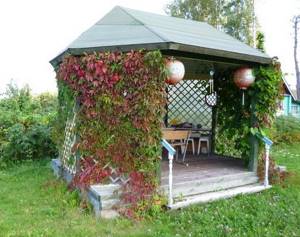
“Living” gazebos are divided into: frame structures and those formed from trees or shrubs. Grape arbors are considered one of the most original and unusual arbors.
A do-it-yourself grape gazebo can look not only of an arched type, but also in the form of a trellis of two planes or as an extension to a house. They can look like light structures or solid ones, with a foundation, for example, made of stone. Your building will be a reflection of your soul, ideas, and imagination.
How many advantages: beauty, sophistication and plus the fruits that you can collect! But you need to understand that not every variety is suitable for picking fruits. As a rule, in order for you to have a gazebo for grapes, you need to take into account the material of the frame - it must be made of metal.
Pruning and shaping grapes. METHOD No. 3 (one-arm cordon)
Over many years of growing grapes on the arbor, many formations have been tested, and the following can be said. Thickened planting gives an increase in yield, especially in the first years. With a 1x3 m planting scheme, we often get an industrial harvest already in the second year after planting (don’t forget that our grapes are rooted). However, in the future, especially when growing vigorous varieties, care becomes more complicated. Now we are installing a support stake at a distance of 3x3 m, but near each pillar we plant two grape bushes, i.e. The planting scheme is 1.5x3 m, and the feeding area of each plant is 4.5 sq.m.
We alternate rows of vigorous varieties with medium-sized ones, for example, Talisman + Delight (for pollination). The result is excellent filling of the gazebo, excellent pollination, convenient care and harvesting. The height of the gazebo is two meters, which allows servicing the bushes from the ground, without any additional equipment, and does not interfere with the free movement of people and equipment. When forming a bush, sometimes we produce two trunks, but more often one. In the first year we form one shoulder of the cordon; in the future, if necessary, the number of shoulders can be increased to two, sometimes to three; not all bushes develop equally, and the free space is easily filled with shoots from a neighboring bush.
When forming a cordon on a gazebo, perennial wood quickly grows, which has a very positive effect on the quantity and quality of the harvest. Carbohydrates accumulate in the wood, which contribute to the development of the bunch in the initial period. In May, there is active growth of shoots and clusters; the supply of nutrients at this moment determines the size of the bunch. The ridge grows to 90% of its size before flowering, and the berries grow after flowering. In the first twenty days, intensive cell division occurs in the berry, i.e. their number multiplies, and only then their sizes increase, so that if there is a lack of nutrition during this period, not enough cells are formed and in the future, even with the best care, the berries do not turn out large : They have nothing to gain size from.
What if you form a single-arm cordon with a cordon length of 6m-1×6 m?
At the same time, there is more perennial wood; the bush’s feeding area is 6 square meters. m; but the load on the root system is greater. Wouldn't such a length be burdensome for the plant in terms of the movement of nutrients, frost resistance, etc.? Or T-shaped two shoulders along Zm with a planting pattern of 2x3 m?
Perennial wood is larger, the feeding area of the bush is 6 square meters. m, in the end we will get more powerful copies; but the load on the root system is also higher. When forming a single-arm six-meter cordon with a planting scheme of 1x6 m of perennial wood, more is actually formed. However, it takes twice as long to develop such a formation: four years instead of two, which reduces the return from the plantation in the first period. Accordingly, the risks increase: in the event of natural disasters, when the formation is lost as a result of frost, disease or other factors, it will again take several years to restore it. In general, the more cumbersome the formation, the less durable it is, because pruning and various other operations cause more damage, which accelerates the aging of the bush, which quickly leads to the replacement of the above-ground part, and this again requires a lot of time and effort.
Base and frame
A gazebo for grapes... many will support this idea, but the most important and difficult question arises: “How to make a gazebo out of grapes?” To begin with, as for a regular gazebo, choose a place where it will be located. Naturally, it is best to place it in the shady part, so that in the heat it will not be so hot and stuffy to be in it.
Next: you need to take measurements of the place. After marking, at a distance of approximately two meters, you need to dig holes under the pipes. It is important to correlate how much the depth should be; it is best to dig a depth of about 70 cm under the pipes. During any construction, it is important to understand that the materials must not only be available, but ready, which will be needed soon!
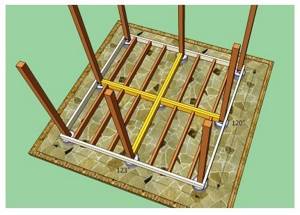
Therefore, after you have dug the holes, you need to pour a little sand (pillow) onto the bottom. Having done this, you can safely proceed with installation and fill these holes with concrete. Next comes the hardest part! At a height of 70 cm from the ground between these holes, cross members can already be welded. The horizontal tier must be installed very accurately.
Everything is schematic - the middle tier from the first is 35-40 cm; third (35-40 cm). The roof and its cross members are created in the same way. It is necessary after the frame is installed, you need to paint it with acrylic enamel, which will preserve the good condition of the gazebo, since it is located on the street, enamel is very important.
Pruning and shaping grapes. METHOD No. 1 (cover formation)
With a half-roof formation, there is a main sleeve 1, its vines 2 are placed on the upper trellis wire, a reserve sleeve 3 is formed perennial and equal in length to the main sleeve 1, it is placed on an additional lower wire. At the base of the bush, one shoot 4 is left, which is cut annually in the fall to the length of the sleeve and, together with the reserve shoot, is lowered to the ground and covered. If the bush has successfully overwintered, annual shoots 5 of reserve sleeve 3 are cut into 2-3 eyes and in the summer 2-3 strong shoots are grown from them. The shoot 4 is cut off by one eye and by autumn a new one is grown in its place.
In case of severe damage to the uncovered part, the main sleeve 1 is cut out, and the reserve sleeve 3 is placed in place of the main one; to restore the reserve sleeve 3, a shoot 4 is used. Using this formation, you can get a harvest every year.
Grape
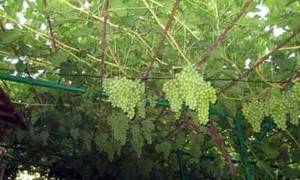
Moving on, we need to decide what to do with the grapes and how to install it all. A DIY grape arbor requires a meticulous approach. It is necessary to plant grapes around the perimeter in combination with a flower bed that already contains the required type of soil.
After you do everything, you need to pull the wire, which is three millimeters in size, above the cuttings, and most importantly, their tops. The grapes should not grow chaotically; by cutting they are given a certain shape. Then the gazebo will have a well-groomed appearance.
How to determine the timing of pruning
It is customary to prune grapes during the resting phase, when the sap flow cycle is absent or minimal. The pruning procedure is carried out in late autumn or early spring. The main factors in determining the timing of pruning the vine:
- Varietal affiliation. Before winter, non-frost-resistant varieties are pruned earlier, and frost-resistant varieties later. In spring it doesn’t matter.
- Wood aging. It occurs before the leaves fall. This process is influenced by atmospheric conditions, rain and fog.
- Purpose of pruning: cuttings for seedlings or forming a bush.
- Temperature control.
- Analysis of the condition of eyes, buds and sprouts.

The grapevine is a living organism. Proteins, sugar and starch are stored in it in reserve by mid-July. 2-3 weeks after the leaves fall, the shoots contain virtually no starch; it moves into the roots and trunk.
This time is most suitable for the pruning procedure. Forming grapes without taking into account its physiological characteristics means depriving it of its supply of nutrients.
When preparing planting material, an abundance of starch is required in the cuttings. In this case, you need to prune the vine immediately after the leaves fall. Such cuttings take root better.
Method for detecting starch
Immerse the cut shoot in an iodine solution. If the cut turns dark, it means there is a lot of starch. Its absence is indicated by a yellowish tint.
Peculiarities
A gazebo on a country site in most cases is a canopy with a roof and semi-open walls, equipped with benches. In addition to these mandatory details, there is an internal table, a stove or barbecue, flower beds and climbing plants, glazing and other pleasant details - it all depends on the imagination and capabilities of the owners of the dacha.
A frame made of a profile pipe for such a street building can have the following advantages:
- it is durable and resistant to deformation and mechanical damage;
- the metal used for the profile is durable;
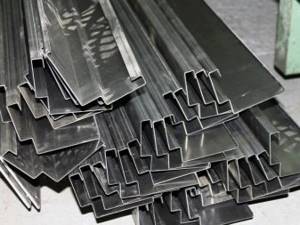
- the construction of such a gazebo can be cheaper than from natural wood, and even more so from natural stone;
- Metal profiles, due to their ease of processing, allow you to create any complex structures;
- In the future, the metal frame can be sheathed with wood, plastic, polycarbonate, and other materials.
For the manufacture of such gazebos, hollow pipes with a rectangular or square cross-section in profile, made of ordinary or galvanized steel, are usually taken. The dimensions and thickness of the walls can be different, the main thing is to calculate that the entire structure can withstand the weight of the roof and other hanging elements. The supporting profiles usually have a larger cross-section, and the lintels are thinner.
Another advantage of metal profiles is that they are hollow, that is, with sufficient strength they are light in weight. When assembled, the elements ensure uniform distribution of loads on all areas of the structure and on the elements associated with it. A rectangular profile is easy to cut, drill holes in it, match it, and make the necessary parts. It is worth considering that when creating reliable gazebos from profile pipes, welding work may be necessary.
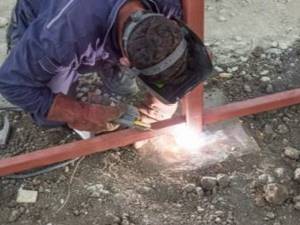
Preparation of the bush
In order to be confident in the future harvest, it is necessary to carefully care for the vineyard throughout the entire period. The grape bush is prepared for pruning in advance and how the vine tolerates it largely depends on its care throughout the season.
A weak, diseased crop with immature wood does not tolerate shaping and pruning well. She is unlikely to survive the frost and will not be ready for spring awakening.
Preparation for pruning includes a whole range of activities:
- Inspect the vines regularly;
- identify fungal diseases and fight them with fungicides;
- thin out bushes, remove diseased and damaged branches and leaves;
- choose varieties that can ripen in the growing region;
- observe the load on the vine and reduce the number of bunches;
- fertilize with mineral and potassium fertilizers and exclude nitrogen fertilizing;
- Monitor the resting and awakening phases of the plant.
Remember that “the vine must suffer.” Fat and fertile soils fertilized with manure make the grapes lazy. They do not allow it to grow a deep root system. In this case, it will be lushly leafy, but not productive.
Adjusting the size of brushes
By following simple rules, you can adjust the size of your brushes, depending on your desire and need. To get large brushes you need:
- Remove half of the trusses of the future harvest at the pea stage - the rest will gain their mass, and the harvest will not decrease, but its quality will improve.
- Water and feed the bushes correctly; without this, there will be no large brushes. We will talk in more detail about the technology of watering and fertilizing in the following articles.
- Remove all vines that are thinner than a pencil, and leave brushes on half of the strongest shoots.
- Do not pollinate brushes artificially.
- A lot of foliage should be left above the ripening bunches.
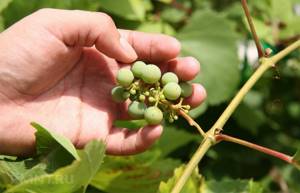
If you want to get brushes of normal size, then leave one on each normal shoot. In this case, there will be more clusters, but their size will be smaller.
If you need a maximum of brushes, and their size is not important, this is usually true for wine varieties, you need:
- Do not limit the space - let the grape bush grow as long as there is space, the more vines, the more brushes.
- Leave vines with 10–20 buds, and a twig is required for each vine.
- It is better to remove vines thinner than a pencil.
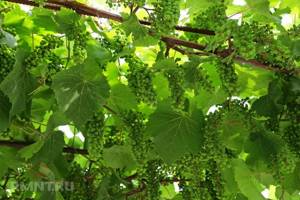
So, we figured out how to form a high-standard bush from a rooted cutting on a trellis or on a gazebo, and found out the advantages of these technologies. Now the choice is yours - everything will depend on your desires and available opportunities. It is important not only to make the heads correctly, but also to give the bushes the correct load, then, if you follow simple rules, you can adjust the size and number of brushes as you wish. In the next article we will talk about how to properly prepare grapes for winter. To be continued…
Pruning in autumn
Non-covering grape varieties are pruned based on the physiology of the vine. In the case when frosts require shelter before the shoots become completely woody, pruning is carried out according to the climatic conditions of the region.
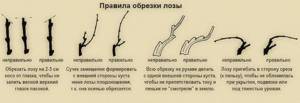
There are two important points to pay attention to:
- Pruning too late allows you to increase the yield of the vine for the next year, but weakens the further growth of the bush.
- Early pruning gives the bush active growth, but reduces its future yield.
You cannot prune the vine when the eye is already beginning to bloom. The buds living in the eye begin to grow and are most susceptible to falling off when the vine is tied to a support (shelter).
The eye appears on the nodes of the vine and in the axils of the leaves. It unites the kidneys and ensures their quality development. In the fall you can observe it and make judgments about next year’s yield. In winter, the peephole is in the sleep phase.
In practice, the formation of a covering vine is carried out the first time in the fall (preliminary pruning) and the second time in the spring (final pruning). When the risk of frost damage to the eyes is too great, then pruning is postponed until spring.
Processing after trimming
The cut site is a living wound and the plant will get sick. Experienced gardeners recommend treating the cut areas with a garden decoction. It will prevent the rotting process and seal the wound from bacteria and microorganisms.
The flow of sap at the site of the cut most often occurs in the spring, when the vine is in the phase of vital activity. However, even with autumn pruning, such treatment will not harm.
In the fall, after harvesting and pruning, but before the onset of frost, it is recommended to treat the grapes with a solution of soda and salt (5 and 10 tablespoons per 10 liters of water, respectively). Treatment is carried out using a spray bottle. Before sheltering for the winter, the vine should be inspected, suspicious areas should be removed and additionally treated with 3% copper sulfate.
Description of the variety
Arched berries are ovoid, with a pointed tip. The famous Arcadia has a similar shape. Their size is stated as large, but winegrowers, spoiled by modern hybrids, would like to see them larger.
The color pink varies in intensity depending on the light level and other factors. In the shade, the berries are colored more intensely. The clusters are of medium density or even dense, weighing about half a kilogram. Their elegant appearance is considered one of the main advantages of the variety.
There is no splitting. The harvest is stored well, including on bushes, and can handle transportation successfully. Opinions are divided on taste. Fans of Arched wine focus on such advantages as a harmonious combination of sugars (16-18%) and acidity (4-5 g/l), a pleasant floral aftertaste. The pulp of the variety is crispy, as they say, marmalade-like.
However, many people are prevented from enjoying food by the thick astringent skin, rather large seeds and simple, as they say, herbaceous taste. Some winegrowers use it for homemade wine, which, when aged for six months, develops a pleasant aroma.
The yield is high and, what is especially valuable, stable. Ripens around mid-August (in the south of Russia), the period is 115-120 days from bud break.
a brief description of
| Color | pink |
| Form | ovoid |
| 6 g / 0.5 kg | |
| 3,8 / 5 |
| Term | early |
| big | |
| -25°С | |
| strong |
The variety is vigorous, produces shoots of 3 meters, starting from the first year of planting. That is why it got its name - it is ideal for covering a gazebo. Resistance is high to mildew and gray rot, while Arched is less resistant to oidium. Although, for example, in the humid conditions of the Lviv region, some winegrowers manage to grow healthy vines without any treatments at all.
Frost resistance is above average, -25°C. When growing on an arch, it does not need to be covered. According to reviews, early and complete ripening of shoots is very convenient. Medium pruning is done. The literature indicates that fruitfulness at the base of the shoots is high, so you can trim it short. The load should be 30-40 eyes per bush.
Reproduction
Cuttings root easily. The variety's compatibility with rootstocks is also at a high level. Due to the large size of an adult bush, the planting hole is prepared as for a fruit tree, at least 80*80*80 cm. If necessary, a drainage layer is laid on the bottom and a pipe is lowered for root watering. The lower part of the pit is filled with fertile soil mixed with humus and mineral fertilizers.
When planting, the seedling is placed on a mound, and the roots are evenly distributed and directed downward. The hole is covered with earth, carefully compacted and watered. The space around is mulched with loose material to retain moisture. In the first year, while the young plant is taking root, water frequently.
Formation
Gardeners recommend giving the trunk the desired shape while the bush is young. Due to the thickness of the vines, they will be difficult to bend once they become woody. Archny accepts feeding with gratitude; increased doses of fertilizers, both organic and mineral, can be given. It is most convenient to fertilize with irrigation water.
Of course, Arched can be grown not only on an arch, as confirmed by the author of the following video:
It should be remembered that the bushes must be watered both before and after applying the nutrient solution. During the growing season, you can spray the leaves with Plantafol. If the berries are pecked by birds or eaten by wasps, protective mesh bags are placed on the bunches.


